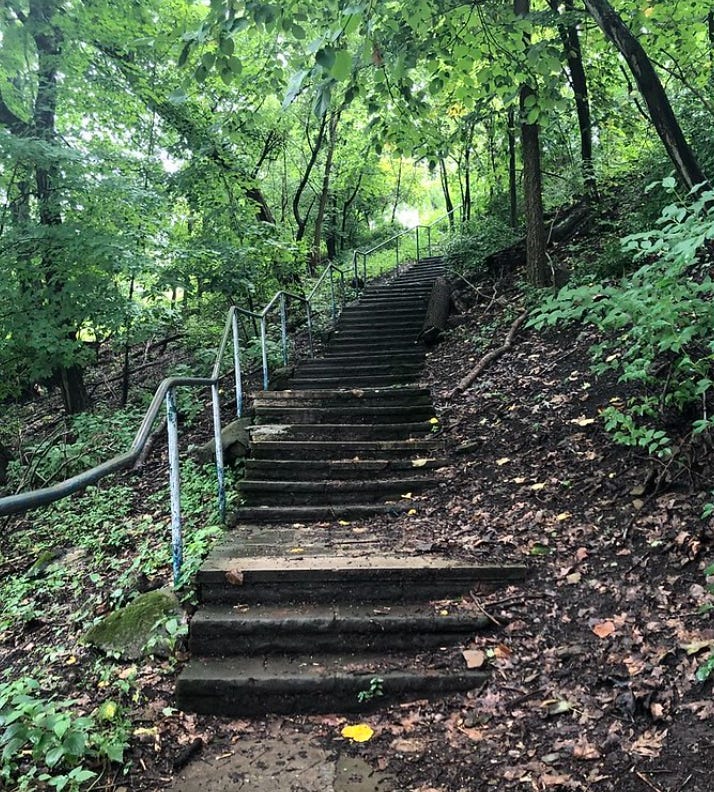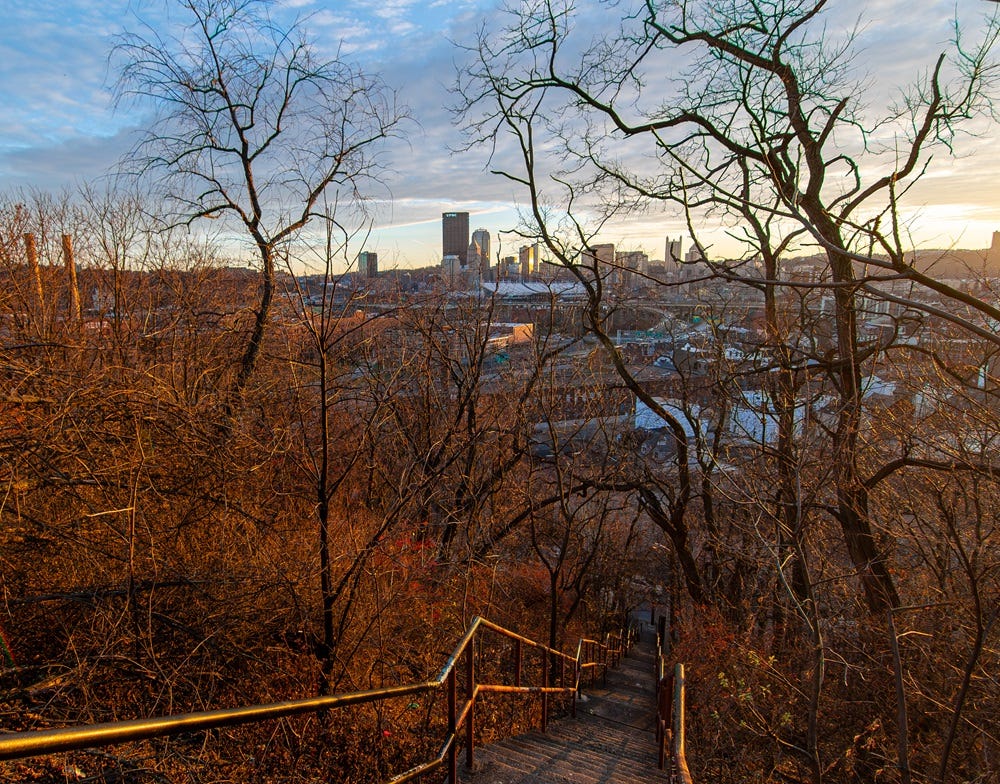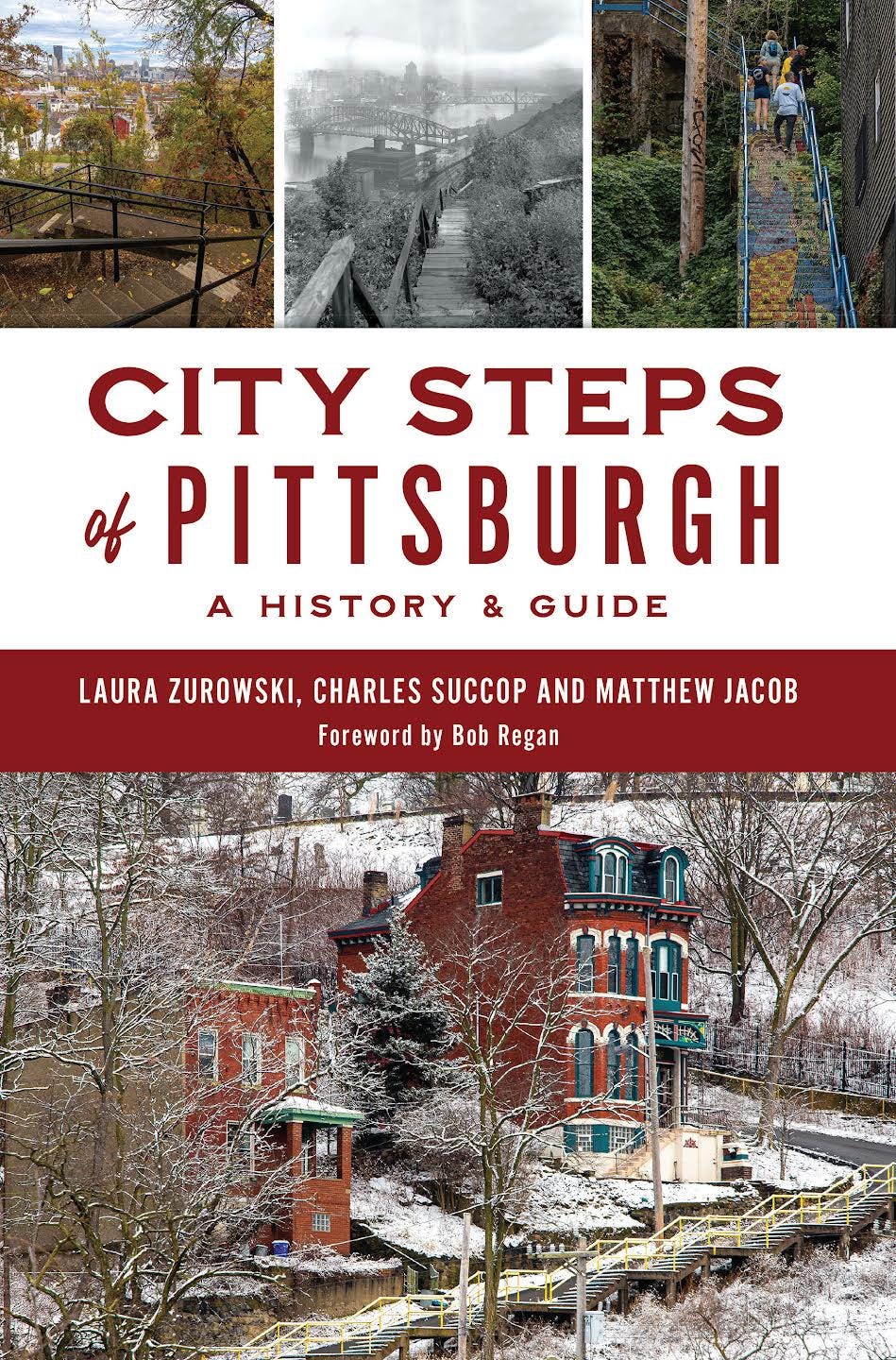Walk Stars: Laura Zurowski
A proud Pittsburgher chronicles the city's labyrinth of steps
One of the perks of running your own publication is being able to make new editorial decisions without getting the approval of a board or a billionaire owner. I could redraw the Mind The Moss logo with lightning bolts extruding from the first “M” and the final “S,” in the vein of the Metallica logo. But this weekend, I’m announcing a meatier new offering; a recurring newsletter series called WALK STARS in which we meet a prolific walker who’s doing something really cool that involves exploring the world on foot.
The first time I spoke with Laura Zurowski was in 2023, during a visit to Pittsburgh centered around one very unique feature of the Steel City—over 700 staircases nestled in the mountainous wooded hills that surround the city. Zurowski, a writer, photographer, and walking tour guide, has spent the last several years documenting the roly-poly beauty of Pittsburgh’s hidden stairways, or “city steps” as most Pittsburghers call them. The steps were created during the industrial era to make it slightly less arduous for workers to commute to the steel mills from their homes on the slopes. Today, they’re a beloved recreational resource and a portal to the city’s history. The South Side Slopes Neighborhood Association, which helps look after many of the steps, leads an annual fundraiser called StepTrek that features a communal circuit hike on the stairs. Taking part in that urban hike was what brought me to Pittsburgh, and into Zurowski’s orbit.
Because the steps are so numerous and different in their composition and size, they can surprise you. It wasn’t long after Zurowski moved to Pittsburgh from Rhode Island in 2013 when she had one of these encounters. “I learned that there was this huge flight of stairs down from the street that I was living on, which would allow me to descend to the neighborhood of Polish Hill, where I have some friends,” Zurowski remembers. “So I thought, “I can take stairs down to Leslie's house, and then we can walk over to our favorite bar, I can have a few beers, and then I can work them off; on the return journey back up the hill.” But it was early summer and as she began using the steps with greater frequency, Zurowski was startled by how quickly the stairway was overwhelmed by fresh bushels of Japanese knotweed. The plant growth was so thick and relentless that Zurowski soon found the staircase impassable. “Since I was the newest person in the neighborhood and using these steps on a pretty regular basis, I went back to my house, I got my clippers, and I just went to work,” Zurowski recalls.
Zurowski’s self-appointed role as a step steward points to a much older and bigger challenge for Pittsburgh residents who enjoy using the stairs recreationally—and those who need the steps to access bus stops or neighborhood businesses. In the 1980s, as Pittsburgh lost a great deal of its population (and tax base) amidst the decline of the steel industry, the city stopped maintaining the steps. Some of them crumbled and others were ensnared with plants. The city also lost many records of the steps. In fact, it wasn’t until 2015 when a University of Pittsburgh geographic systems professor named Bob Regan released a full accounting of the steps with his book, Pittsburgh Steps: The Story of the City’s Public Stairways. Regan had spent years biking and walking around Pittsburgh, to confirm the existence and accessibility of the forgotten steps. And when Zurowski discovered his book, an idea began stirring to life.
“Bob had graciously given his data to the city, at their request, so that they could make digital maps and databases that would help more people access the steps,” Zurowski told me. “But when I picked up Bob’s book, one thing that really jumped out at me was the 34-page appendix at the back; which basically explains where all 739 of the steps that he had found on his journey are located. And I wondered how long it might take to go out and visit all of them.” Poring over online maps, Zurowski estimated that she could recreate Regan’s 20-year journey in a quarter of that time. But heading out and finding the steps was only half the allure; Zurowski wanted to chronicle them in her own way.
”What I was starting to realize as a new resident is that Pittsburgh’s steps are a super important feature in the collective memory of the city,” Zuroswki says. “The steps hold a fond place in a lot of people’s hearts. They can be a window back to one’s childhood and to very unique stories from those years.” This is one of the reasons why Zuorwski decided to document each stairway that she located with a Polaroid Spectra camera and a short written creative non-fiction story inspired by her time walking on the steps. Zurowski published her photographs and stories on a website and Instagram account called Mis.Steps, which soon garnered a very large following from within and outside the city. And as the project progressed, Zurowski started to meet more Pittsburghers on her walks and through the Internetu—Pittsburghers who were eager to share their own step stories with Zurowski, before she set off to revisit their favorite stairways.
”There’s one woman who lives on the south side of the city who told me how well she remembers sitting on the steps near her house as a little girl, all excited and waiting for her dad to appear on his climb back up from work,” Zurowski told me. “And then there are the recurring stories that I’ve heard from lots of different folks; stories about how the steps were places where you could escape your parents if you wanted to smoke a cigarette, drink a beer, or spend some time with your girlfriend who your mom hated. You know, if you're living in a small house and you’ve got brothers and sisters, you’re living in an environment where you don’t have much personal space. And city steps can end up becoming third places, where you can freely gather or engage with others.”
Ongoing waves of development in Pittsburgh, coupled with the population loss from which the city hasn’t fully recovered, can make these shared memories of steps feel borderline endangered. “Pittsburgh is a very different city today compared with 40 or 50 years ago, and now there are lots and lots of people who don’t realize that there used to be steel mills here; let alone that there are all these stairs,” Zurowski says. It took around five years for Zurowski to reach the 739th staircase that Bob Regan had documented in his book. And during that time, the City of Pittsburgh had made huge strides towards digitizing old city maps and records that had been temporarily lost or squirreled away in a storage facility when Regan was mapping the steps. What this newly available information revealed for Zurowski and other step aficionados like her was that there were even more lost staircases around Pittsburgh, waiting to be found.
During the Mis.Steps years, Zurowski had become friends with Regan and two fellow step chasers; Matthew Jacob, who created the city’s database of public stairways and other public assets for public works, and Charles Succop, the city archivist. And as they considered the rate at which the city was transforming and the revelation that the Pittsburgh steps ecosystem was bigger than they had realized, Zurowski, Jacob, and Succop started mulling an idea—a vision for a new book about Pittsburgh’s labyrinth of steps. And one of the primary components of the book, in addition to unearthed history, would be blueprints for step walking tours.
Regan gave the trio his blessing when they told him about their idea; enthused to see three fellow Pittsburghers taking up the mantle of step chronicling. “Pulling the book together took about 15 months and each of us had a distinct role,” Zurowski says. “Charles was responsible for the research, both the newly located and digitized material in the city archives and other sources. Matt was our photographer and map maker, and I wrote the narratives. The three of us collaborated on the walking tours because for each walk, we wanted to present interesting history and beautiful photos that would inspire and motivate people to get outside.” But the mud, sweat, and tears paid off. City Steps of Pittsburgh: A History & Guide was picked up by The History Press and released in July of 2024. The book went into its second printing in December, and an audiobook produced by Tantor Media will be released later this year.
Take it from both Zurowski and me. If you have never been to Pittsburgh—or if you’ve never been to the city with the intention of taking an epic urban hike—2025 is the year to change that. The elation of finding a staircase that disappears into a tunnel of trees is a special kind of heaven; as is the feeling of reaching the top of a long procession of steps, as sweaty as you’d feel after scaling Mount Marcy, and being treated to the cool breeze on your moist backside and a killer view of the converging Allegheny and Monongahela Rivers near downtown Pittsburgh. So to close out this inaugural edition of Walk Stars, here are three planning tips for your first voyage to Pittsburgh’s steps.
Get started by following the mapmakers. Because there are so many steps in the city, the potential number of curated walking routes up and down select stairways is pretty much limitless. In addition to all of the step walks outlined in her book, Zurowski has helpfully compiled an online collection of guiding resources, such as maps from prior StepTrek hikes. (I can affirm that the 2015 “Gold Route” is a bonafide glute tenderizer.)
Use the new city resourcesu—and Zurowski’s booku—to go deeper. Once you’ve covered some of the more well tread steps in Pittsburgh, it’s time to start scrolling around the digital map of the steps that the City of Pittsburgh used Bob Regan’s data to create. Wherever you’re eating or shopping or sleeping in Pittsburgh, odds are there’s a staircase near you. But here’s an important caveat. If you happen upon a staircase that dead-ends in the woods or a partially ruined set of steps—and you’re on your own—come back with a buddy and tackle it together. In their book, Zurowski, Jacob, and Succop offer some very useful safety tips for adventuring up these forlorn stairs; such as saving those forays for winter or early spring, before the greenery has returned and obscured potential underfoot hazards.
“A lot of Pittsburgh hills used to have housing and infrastructure that’s gone now, and you can’t see what all the leaves and plants may be covering,” Zurowski says. “You don’t want to bushwhack your way into a sewer opening, or a mine shaft!”
Join or commission a walking tour from Zurowski. Since the Mis.Steps era, Zurowski has been organizing and hosting group foot tours of the stairs and streets that she’s come to know so well. Past walks have often ended at a city brewery or cider mill, and you can see if Zurowski is leading any upcoming walks by checking out the City Steps Walking Tours section of her website. And if there’s nothing on the calendar during the time of your Pittsburgh visit, you can commission a private group tour from Zurowski.
”The big idea behind these walks is, you can come and do this again,” Zurowski says. “Maybe you’ll bring your dog to a particular set of stairs. Maybe you’ll bring the city map of all the steps. Either way, those steps are still here, and they’re for everyone.”
You can keep up with Zurowski’s current foot journeys, writing, and photography by subscribing to her newsletter, Pittsburgh’s Green and Gray—a showcase of the city’s parks, playgrounds, and trails. (Zurowski, Jacob, and Succop are already at work on a new book about this, with an anticipated October 2026 release date!) You can also follow her on Instagram and on BlueSky. And while you’re at it, check out Matt Jacob’s Instragram account, which is pretty much a showcase of Pittsburgh steps grandeur.










I have to get out there!